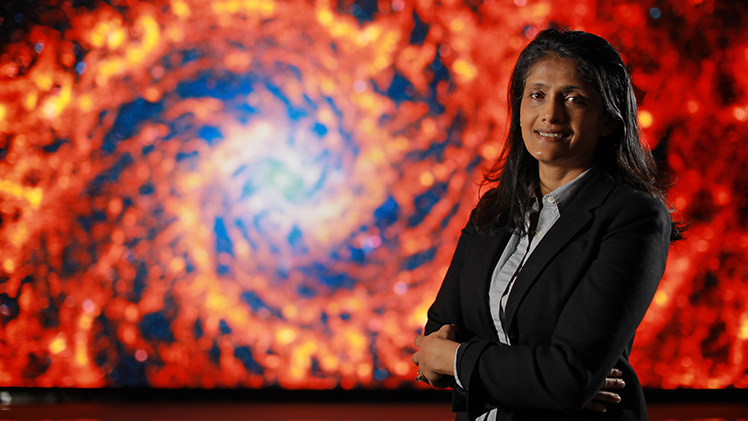When it comes to outer space, even astronomers have more questions than answers.
A worldwide network of researchers is working toward some of those answers while raising new questions with its survey of 19 nearby spiral galaxies using the James Webb Space Telescope. Their recently released images reveal intricate networks of gas, dust and stars, offering insights into early star formation and galaxy evolution and furthering the data-driven mission of the research program known as Physics at High Angular resolution in Nearby GalaxieS (PHANGS).

Dr. Rupali Chandar, professor and associate chair of the Department of Physics and Astronomy, is a core member of a research program that released images of 19 nearby spiral galaxies using the James Webb Space Telescope on Monday.
“The images of the galaxies are just stunning,” said Dr. Rupali Chandar, professor and associate chair of the Department of Physics and Astronomy at The University of Toledo and a core member of PHANGS. “And they’re not what we expected. We’re learning a huge amount from them.”
Chandar, whose expertise is in extragalactic stellar populations, has been involved in the research program since the beginning and it’s grown to now be supported by more than 150 astronomers. As one of more than 20 core members, she contributes to collaborative research projects, like the James Webb survey, and to shaping the policies and practices that guide the collaboration.
PHANGS’ mission is to observe nearby galaxies by collecting high-resolution observations across the electromagnetic spectrum in order to advance astronomers’ understanding of the physical processes that drive star formation and galaxy evolution. PHANGS researchers have already recorded observations in ultraviolet, visible and radio light using NASA’s Hubble Space Telescope in space and the Very Large Telescope (VLT) and Atacama Large Millimeter/ submillimeter Array (ALMA) on the ground.
This all makes for a treasure trove of information that researchers can use to inform their understanding of the cosmos, as well as to test theories and compare with computer-generated predictions that might or might not align with the actual workings of a mysterious universe.
“There’s a lot of theoretical work in our field that predicts certain processes related to star formation, stellar feedback and galaxy evolution, but we haven’t had the observations to test those predictions in detail,” Chandar said. “PHANGS is collecting the data set that will allow us to do that.”
Chandar is the principal investigator on another observation program for PHANGS, in which she’s using the Hubble Space Telescope to image the same 19 galaxies recently observed using the James Webb. She’s capturing data and images at the H-alpha wavelength, rather than the near- and mid-infrared wavelengths that are possible with the James Webb. The H-alpha observations will reveal the birth places of massive stars and star clusters and complement the James Webb and other datasets to provide a holistic look at massive star-forming galaxies.
That PHANGS H-Alpha observing program is ongoing, with all but one galaxy set to be observed by the end of April.
Outside of PHANGS Chandar is also the principal investigator on two research programs on the James Webb, one on massive young star clusters that was approved in the first cycle of the general observer program and another exploring cluster formation theories that was approved in the second cycle.
She and several department colleagues are awaiting notification on cycle three proposals.
The James Webb is lauded as the largest, most powerful and most complex telescope ever launched into space, and the stunning cosmic landscapes it’s revealed have mesmerized professional and hobbyist astronomers alike since the very first images were released in July 2022.
PHANGS’ James Webb images, which were released on Jan. 29, are the latest powerful images with their depiction of an enthralling cosmic patchwork. Each galaxy image shares common features in its blue-hued stars and the red-orange swirls of dust and gas that seem to glow around them.
Science isn’t usually a sprint, but the PHANGS James Webb survey has been unusually fast-paced for astronomers who are more attuned to the slow burn of an academic marathon. PHANGS researchers released their findings on four of the 19 nearby spiral galaxies in a special focus issue of The Astrophysical Journal Letters in February 2023. That was just over a year after the launch of the space telescope on Dec. 25, 2021, and just months after researchers received the data that they in turn analyzed in the 21 research articles included in that issue. Chandar is a co-author on eight.
The collaborators’ work – then and now, with the release of images and data on the full complement of 19 galaxies – offers valuable insights into early star formation in spiral galaxies, like our own in the Milky Way, that go beyond what astronomers have gleaned from the Hubble, ALMA and VLT. With its Mid-Infrared Instrument (MIRI), for example, the James Webb is able to cut through the dusty interstellar medium that blocks the passage of visible light.
James Webb images have revealed networks of gas and dust that are shaped by gas flows, star formation and stellar feedback, as well as heretofore unobserved shells and bubble-like features along the spiral arms of the galaxies. Researchers believe the latter may be carved out by stellar feedback, which includes stellar winds, radiation and supernova explosions.
Chandar said they’re exciting observations.
“We thought we had a fairly advanced understanding of the processes that drive star formation and in turn shape the arms of spiral galaxies, but the James Webb data is making very clear that these bubbles play a critical and previously underappreciated role,” Chandar said. “One of the things we’re going to work on now is quantifying their impact and better understanding how they enhance and trigger star formation, and how they shape spiral structure.”